Critical Success Factors in Sustainable Supply Chain Management
VerifiedAdded on 2020/05/28
|42
|9315
|42
AI Summary
The purpose of this research analysis is to explore and evaluate the critical success factors (CSFs) in implementing supply chain information systems across different industries. By examining a range of scholarly sources such as Denolf et al. (2015), Govindan et al. (2014), and others, this assignment aims to provide a comprehensive understanding of the challenges and strategies associated with these implementations. Key areas of focus include identifying barriers through analytical approaches like AHP, understanding sustainability issues within multi-tier supply chains, and leveraging frameworks for effective integration as discussed by authors such as Stadtler (2015) and Mellor et al. (2014). Additionally, the analysis will incorporate methodologies highlighted in works like Sekaran and Bougie (2016), ensuring a methodologically robust evaluation of existing literature. Ultimately, this research seeks to offer insights into best practices for organizations aiming to enhance their supply chain efficiency through advanced information systems.
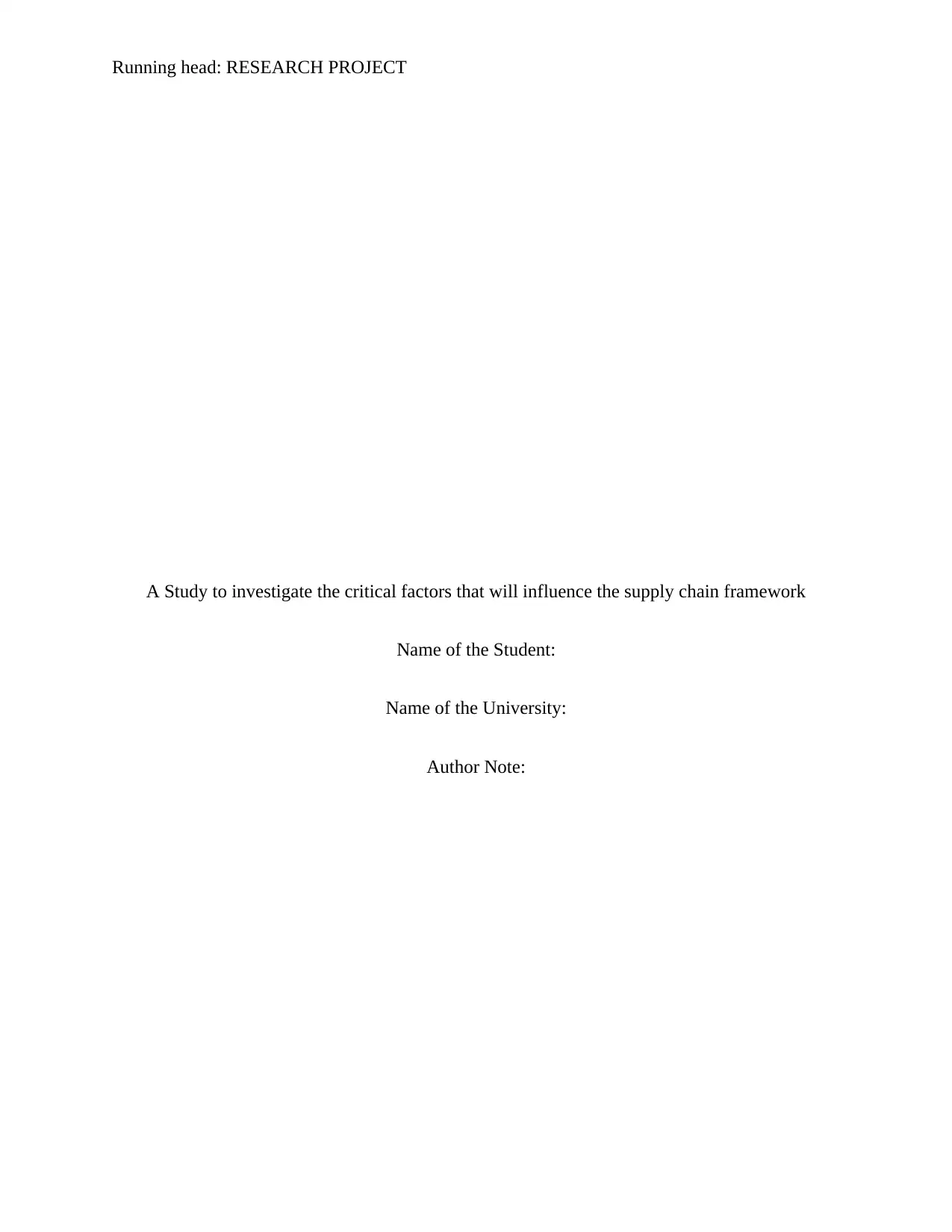
Running head: RESEARCH PROJECT
A Study to investigate the critical factors that will influence the supply chain framework
Name of the Student:
Name of the University:
Author Note:
A Study to investigate the critical factors that will influence the supply chain framework
Name of the Student:
Name of the University:
Author Note:
Paraphrase This Document
Need a fresh take? Get an instant paraphrase of this document with our AI Paraphraser

1RESEARCH PROJECT
Acknowledgment
I would like to thank my supervisor who has provided me the opportunity to work on this
research study that is based on “Critical factors that will influence the supply chain framework”.
I would also like to thank my co-workers and my friends who has supported me in carrying out
the research. I would like to thank Mr. ___________________ who has guided me in each step
of the research study. I would also like to thank my parents for providing me moral and financial
support.
Acknowledgment
I would like to thank my supervisor who has provided me the opportunity to work on this
research study that is based on “Critical factors that will influence the supply chain framework”.
I would also like to thank my co-workers and my friends who has supported me in carrying out
the research. I would like to thank Mr. ___________________ who has guided me in each step
of the research study. I would also like to thank my parents for providing me moral and financial
support.

2RESEARCH PROJECT
Contents
1. Introduction..................................................................................................................................4
What is the setting for your project?............................................................................................4
What are the aims of your project?..............................................................................................4
What is your project about?.........................................................................................................4
How and why did you chose the project?....................................................................................6
2. Literature Review........................................................................................................................6
2.1 Framework for green supply chain management...................................................................6
2.2. Critical factors for the success of supply chain....................................................................7
2.2.1 Communication...............................................................................................................8
2.2.2 Manage relationships......................................................................................................8
2.2.3 Planning tools.................................................................................................................9
2.2.4 Build plans and vision....................................................................................................9
2.2.5. Take up management responsibility..............................................................................9
2.2.6 Share benefits, costs and risks......................................................................................10
2.2.7 Manage data..................................................................................................................10
2.2. 8 Train the users and manage change in the organization..............................................11
2.2.9 Monitor and evaluate performance...............................................................................11
2.2.10 Reengineer processes..................................................................................................12
2.2.11 Assess the legacy and the IT system...........................................................................12
Contents
1. Introduction..................................................................................................................................4
What is the setting for your project?............................................................................................4
What are the aims of your project?..............................................................................................4
What is your project about?.........................................................................................................4
How and why did you chose the project?....................................................................................6
2. Literature Review........................................................................................................................6
2.1 Framework for green supply chain management...................................................................6
2.2. Critical factors for the success of supply chain....................................................................7
2.2.1 Communication...............................................................................................................8
2.2.2 Manage relationships......................................................................................................8
2.2.3 Planning tools.................................................................................................................9
2.2.4 Build plans and vision....................................................................................................9
2.2.5. Take up management responsibility..............................................................................9
2.2.6 Share benefits, costs and risks......................................................................................10
2.2.7 Manage data..................................................................................................................10
2.2. 8 Train the users and manage change in the organization..............................................11
2.2.9 Monitor and evaluate performance...............................................................................11
2.2.10 Reengineer processes..................................................................................................12
2.2.11 Assess the legacy and the IT system...........................................................................12
⊘ This is a preview!⊘
Do you want full access?
Subscribe today to unlock all pages.

Trusted by 1+ million students worldwide
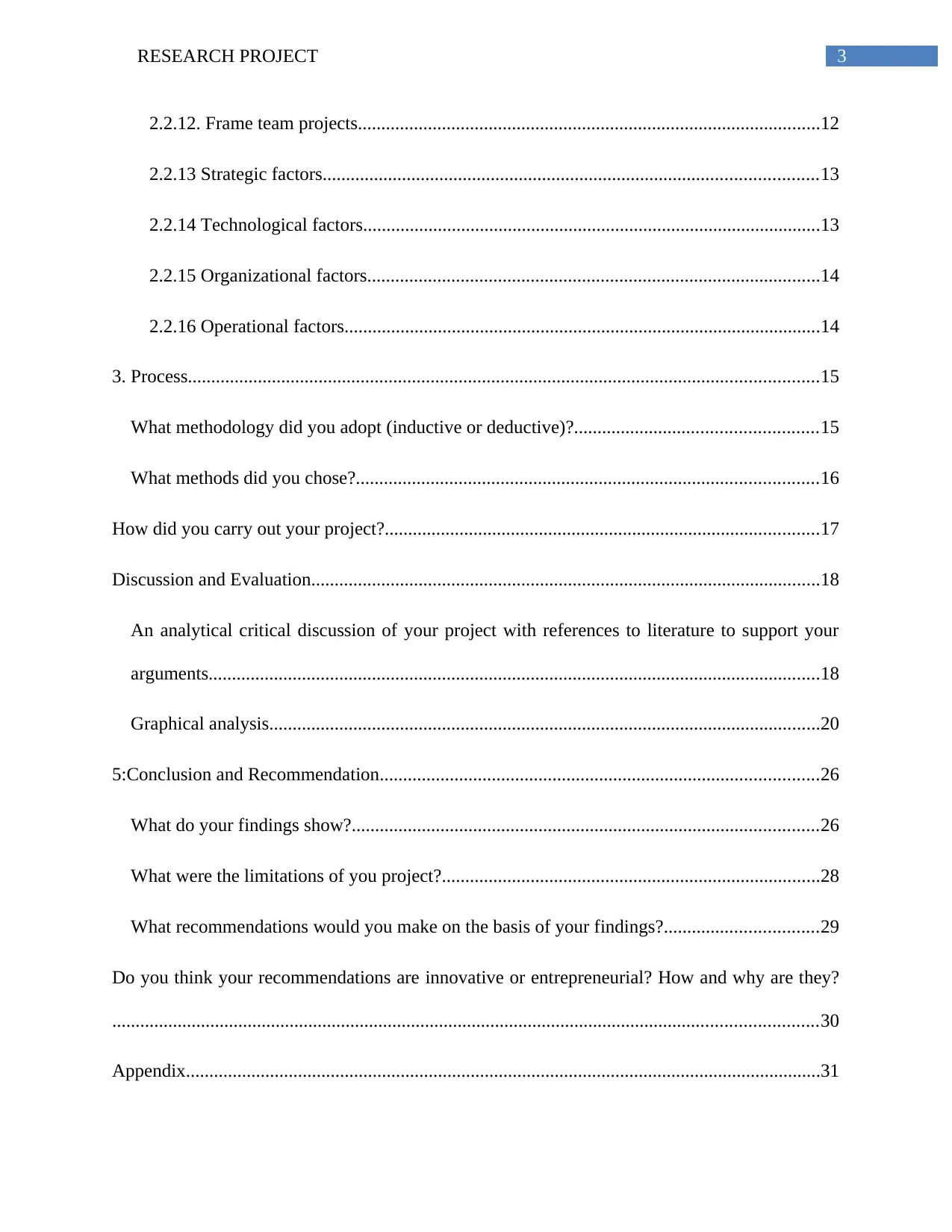
3RESEARCH PROJECT
2.2.12. Frame team projects...................................................................................................12
2.2.13 Strategic factors..........................................................................................................13
2.2.14 Technological factors..................................................................................................13
2.2.15 Organizational factors.................................................................................................14
2.2.16 Operational factors......................................................................................................14
3. Process.......................................................................................................................................15
What methodology did you adopt (inductive or deductive)?....................................................15
What methods did you chose?...................................................................................................16
How did you carry out your project?.............................................................................................17
Discussion and Evaluation.............................................................................................................18
An analytical critical discussion of your project with references to literature to support your
arguments...................................................................................................................................18
Graphical analysis......................................................................................................................20
5:Conclusion and Recommendation..............................................................................................26
What do your findings show?....................................................................................................26
What were the limitations of you project?.................................................................................28
What recommendations would you make on the basis of your findings?.................................29
Do you think your recommendations are innovative or entrepreneurial? How and why are they?
.......................................................................................................................................................30
Appendix........................................................................................................................................31
2.2.12. Frame team projects...................................................................................................12
2.2.13 Strategic factors..........................................................................................................13
2.2.14 Technological factors..................................................................................................13
2.2.15 Organizational factors.................................................................................................14
2.2.16 Operational factors......................................................................................................14
3. Process.......................................................................................................................................15
What methodology did you adopt (inductive or deductive)?....................................................15
What methods did you chose?...................................................................................................16
How did you carry out your project?.............................................................................................17
Discussion and Evaluation.............................................................................................................18
An analytical critical discussion of your project with references to literature to support your
arguments...................................................................................................................................18
Graphical analysis......................................................................................................................20
5:Conclusion and Recommendation..............................................................................................26
What do your findings show?....................................................................................................26
What were the limitations of you project?.................................................................................28
What recommendations would you make on the basis of your findings?.................................29
Do you think your recommendations are innovative or entrepreneurial? How and why are they?
.......................................................................................................................................................30
Appendix........................................................................................................................................31
Paraphrase This Document
Need a fresh take? Get an instant paraphrase of this document with our AI Paraphraser

4RESEARCH PROJECT
References......................................................................................................................................35
1. Introduction
What is the setting for your project?
The paper is divided in the following section. Part 1 will deal with the
introduction of the paper and it will highlight the research objectives, research motivation and
contribution. Part 2 will highlight the literature, which was conducted by the previous scholars,
and this will help to recognize the independent variable and thus build up the research
hypothesis. In part 3, the data collection method and research methodology will be described in
details. Moreover, Section 4 will highlight and compare the findings of the previous studies.
Section 5 will deal with conclusion of the paper.
What are the aims of your project?
The main objective of the project is to analyse the critical factors that will affect
the supply chain. It will also investigate how to minimize the critical factors so that it becomes
easier to maintain the supply chain framework. Moreover, it will also highlight the critical
factors and the supply chain element that are dependent on each other.
What is your project about?
The project is associated with the supply chain framework and the various factors
that will affect the supply chain. The recognition of the factors are important and it was also
highlighted by the previous researchers. The company must develop proper relationship with the
suppliers and thus it will help in developing the level of commitment. The supply chain
References......................................................................................................................................35
1. Introduction
What is the setting for your project?
The paper is divided in the following section. Part 1 will deal with the
introduction of the paper and it will highlight the research objectives, research motivation and
contribution. Part 2 will highlight the literature, which was conducted by the previous scholars,
and this will help to recognize the independent variable and thus build up the research
hypothesis. In part 3, the data collection method and research methodology will be described in
details. Moreover, Section 4 will highlight and compare the findings of the previous studies.
Section 5 will deal with conclusion of the paper.
What are the aims of your project?
The main objective of the project is to analyse the critical factors that will affect
the supply chain. It will also investigate how to minimize the critical factors so that it becomes
easier to maintain the supply chain framework. Moreover, it will also highlight the critical
factors and the supply chain element that are dependent on each other.
What is your project about?
The project is associated with the supply chain framework and the various factors
that will affect the supply chain. The recognition of the factors are important and it was also
highlighted by the previous researchers. The company must develop proper relationship with the
suppliers and thus it will help in developing the level of commitment. The supply chain
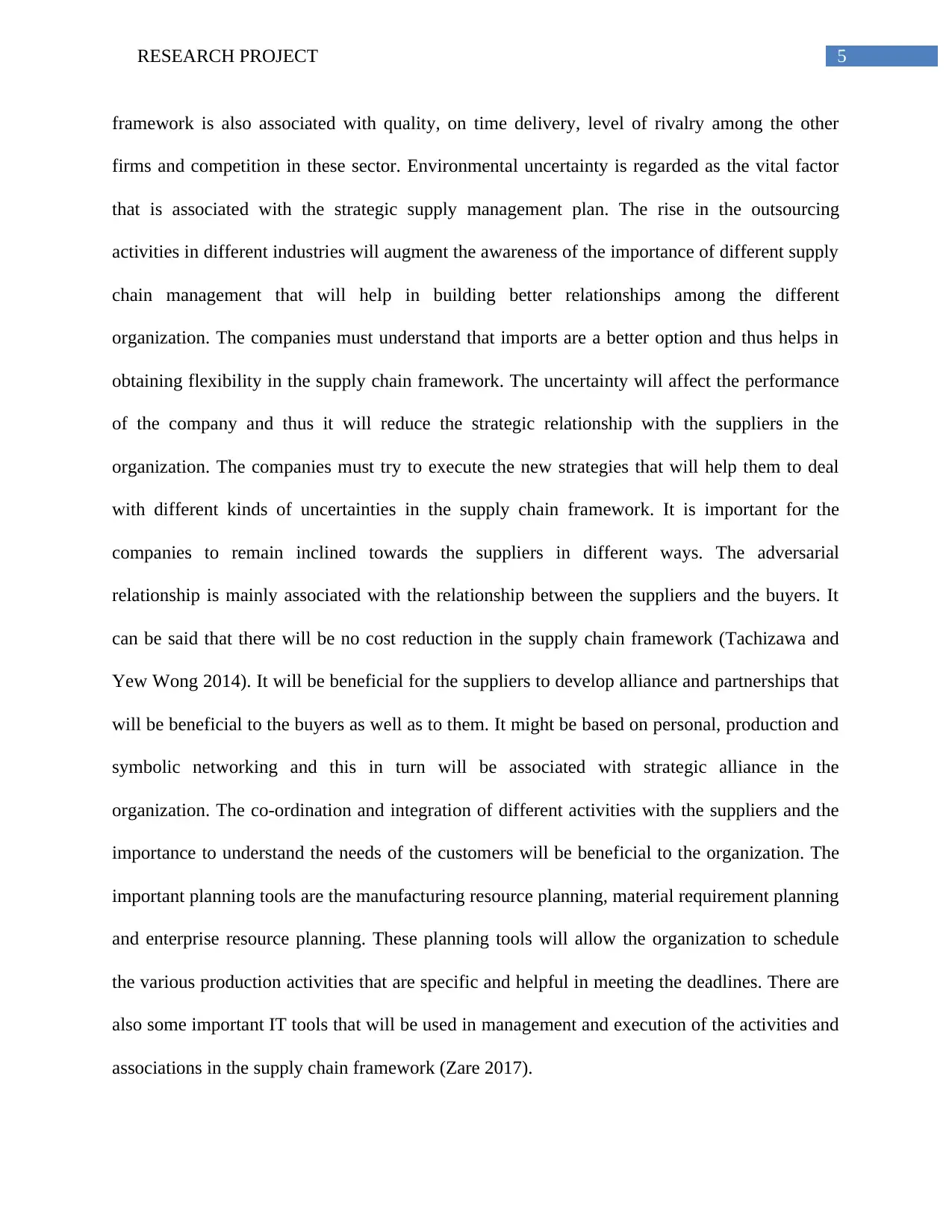
5RESEARCH PROJECT
framework is also associated with quality, on time delivery, level of rivalry among the other
firms and competition in these sector. Environmental uncertainty is regarded as the vital factor
that is associated with the strategic supply management plan. The rise in the outsourcing
activities in different industries will augment the awareness of the importance of different supply
chain management that will help in building better relationships among the different
organization. The companies must understand that imports are a better option and thus helps in
obtaining flexibility in the supply chain framework. The uncertainty will affect the performance
of the company and thus it will reduce the strategic relationship with the suppliers in the
organization. The companies must try to execute the new strategies that will help them to deal
with different kinds of uncertainties in the supply chain framework. It is important for the
companies to remain inclined towards the suppliers in different ways. The adversarial
relationship is mainly associated with the relationship between the suppliers and the buyers. It
can be said that there will be no cost reduction in the supply chain framework (Tachizawa and
Yew Wong 2014). It will be beneficial for the suppliers to develop alliance and partnerships that
will be beneficial to the buyers as well as to them. It might be based on personal, production and
symbolic networking and this in turn will be associated with strategic alliance in the
organization. The co-ordination and integration of different activities with the suppliers and the
importance to understand the needs of the customers will be beneficial to the organization. The
important planning tools are the manufacturing resource planning, material requirement planning
and enterprise resource planning. These planning tools will allow the organization to schedule
the various production activities that are specific and helpful in meeting the deadlines. There are
also some important IT tools that will be used in management and execution of the activities and
associations in the supply chain framework (Zare 2017).
framework is also associated with quality, on time delivery, level of rivalry among the other
firms and competition in these sector. Environmental uncertainty is regarded as the vital factor
that is associated with the strategic supply management plan. The rise in the outsourcing
activities in different industries will augment the awareness of the importance of different supply
chain management that will help in building better relationships among the different
organization. The companies must understand that imports are a better option and thus helps in
obtaining flexibility in the supply chain framework. The uncertainty will affect the performance
of the company and thus it will reduce the strategic relationship with the suppliers in the
organization. The companies must try to execute the new strategies that will help them to deal
with different kinds of uncertainties in the supply chain framework. It is important for the
companies to remain inclined towards the suppliers in different ways. The adversarial
relationship is mainly associated with the relationship between the suppliers and the buyers. It
can be said that there will be no cost reduction in the supply chain framework (Tachizawa and
Yew Wong 2014). It will be beneficial for the suppliers to develop alliance and partnerships that
will be beneficial to the buyers as well as to them. It might be based on personal, production and
symbolic networking and this in turn will be associated with strategic alliance in the
organization. The co-ordination and integration of different activities with the suppliers and the
importance to understand the needs of the customers will be beneficial to the organization. The
important planning tools are the manufacturing resource planning, material requirement planning
and enterprise resource planning. These planning tools will allow the organization to schedule
the various production activities that are specific and helpful in meeting the deadlines. There are
also some important IT tools that will be used in management and execution of the activities and
associations in the supply chain framework (Zare 2017).
⊘ This is a preview!⊘
Do you want full access?
Subscribe today to unlock all pages.

Trusted by 1+ million students worldwide
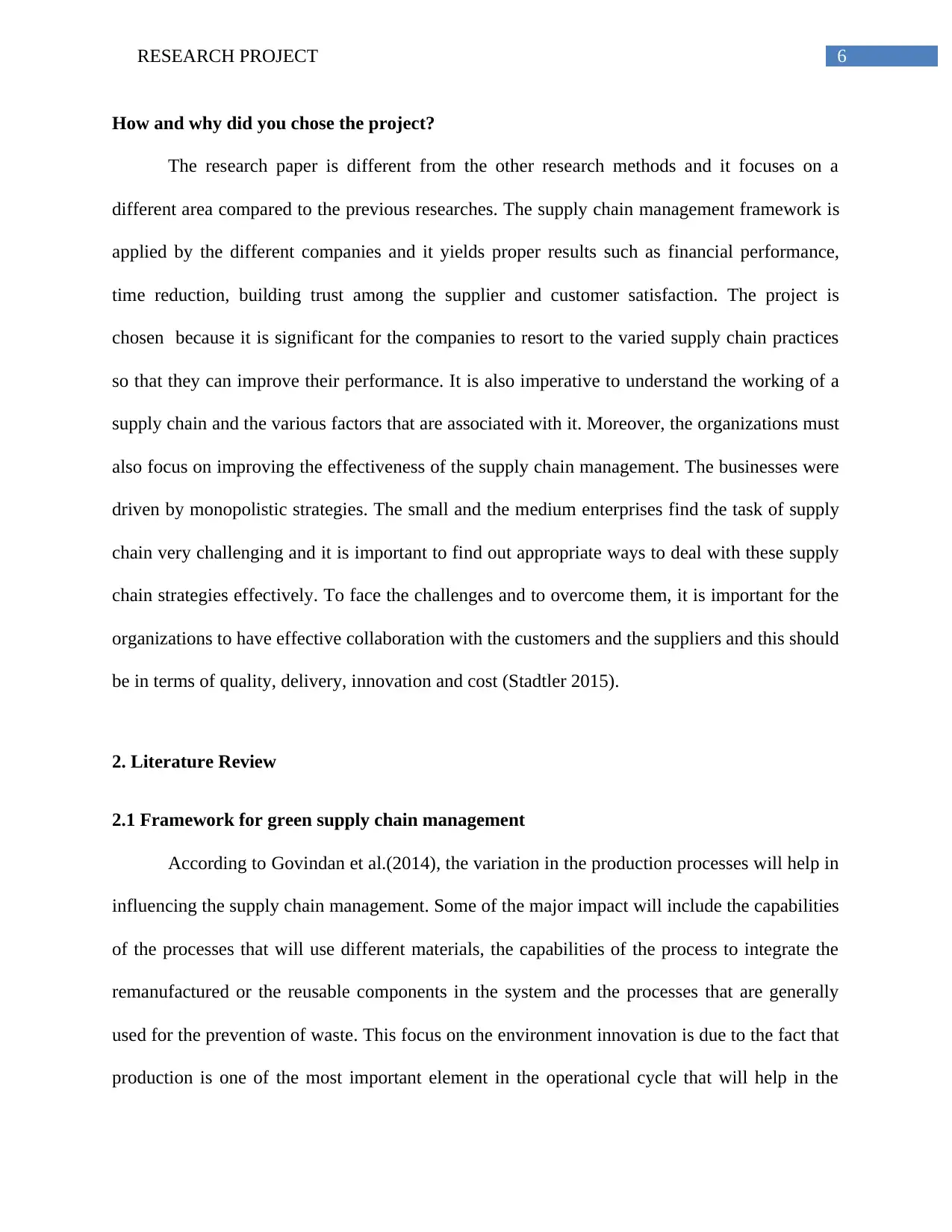
6RESEARCH PROJECT
How and why did you chose the project?
The research paper is different from the other research methods and it focuses on a
different area compared to the previous researches. The supply chain management framework is
applied by the different companies and it yields proper results such as financial performance,
time reduction, building trust among the supplier and customer satisfaction. The project is
chosen because it is significant for the companies to resort to the varied supply chain practices
so that they can improve their performance. It is also imperative to understand the working of a
supply chain and the various factors that are associated with it. Moreover, the organizations must
also focus on improving the effectiveness of the supply chain management. The businesses were
driven by monopolistic strategies. The small and the medium enterprises find the task of supply
chain very challenging and it is important to find out appropriate ways to deal with these supply
chain strategies effectively. To face the challenges and to overcome them, it is important for the
organizations to have effective collaboration with the customers and the suppliers and this should
be in terms of quality, delivery, innovation and cost (Stadtler 2015).
2. Literature Review
2.1 Framework for green supply chain management
According to Govindan et al.(2014), the variation in the production processes will help in
influencing the supply chain management. Some of the major impact will include the capabilities
of the processes that will use different materials, the capabilities of the process to integrate the
remanufactured or the reusable components in the system and the processes that are generally
used for the prevention of waste. This focus on the environment innovation is due to the fact that
production is one of the most important element in the operational cycle that will help in the
How and why did you chose the project?
The research paper is different from the other research methods and it focuses on a
different area compared to the previous researches. The supply chain management framework is
applied by the different companies and it yields proper results such as financial performance,
time reduction, building trust among the supplier and customer satisfaction. The project is
chosen because it is significant for the companies to resort to the varied supply chain practices
so that they can improve their performance. It is also imperative to understand the working of a
supply chain and the various factors that are associated with it. Moreover, the organizations must
also focus on improving the effectiveness of the supply chain management. The businesses were
driven by monopolistic strategies. The small and the medium enterprises find the task of supply
chain very challenging and it is important to find out appropriate ways to deal with these supply
chain strategies effectively. To face the challenges and to overcome them, it is important for the
organizations to have effective collaboration with the customers and the suppliers and this should
be in terms of quality, delivery, innovation and cost (Stadtler 2015).
2. Literature Review
2.1 Framework for green supply chain management
According to Govindan et al.(2014), the variation in the production processes will help in
influencing the supply chain management. Some of the major impact will include the capabilities
of the processes that will use different materials, the capabilities of the process to integrate the
remanufactured or the reusable components in the system and the processes that are generally
used for the prevention of waste. This focus on the environment innovation is due to the fact that
production is one of the most important element in the operational cycle that will help in the
Paraphrase This Document
Need a fresh take? Get an instant paraphrase of this document with our AI Paraphraser
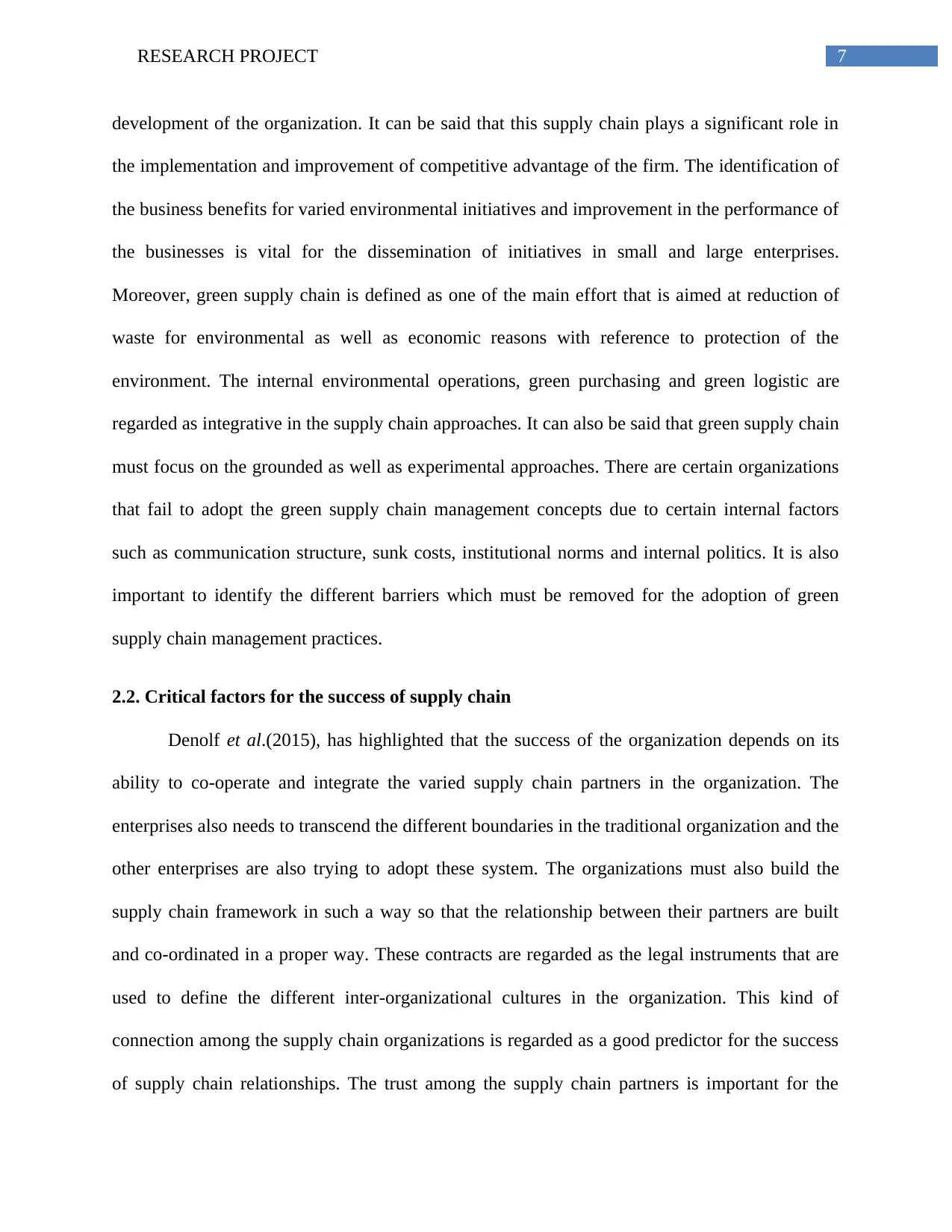
7RESEARCH PROJECT
development of the organization. It can be said that this supply chain plays a significant role in
the implementation and improvement of competitive advantage of the firm. The identification of
the business benefits for varied environmental initiatives and improvement in the performance of
the businesses is vital for the dissemination of initiatives in small and large enterprises.
Moreover, green supply chain is defined as one of the main effort that is aimed at reduction of
waste for environmental as well as economic reasons with reference to protection of the
environment. The internal environmental operations, green purchasing and green logistic are
regarded as integrative in the supply chain approaches. It can also be said that green supply chain
must focus on the grounded as well as experimental approaches. There are certain organizations
that fail to adopt the green supply chain management concepts due to certain internal factors
such as communication structure, sunk costs, institutional norms and internal politics. It is also
important to identify the different barriers which must be removed for the adoption of green
supply chain management practices.
2.2. Critical factors for the success of supply chain
Denolf et al.(2015), has highlighted that the success of the organization depends on its
ability to co-operate and integrate the varied supply chain partners in the organization. The
enterprises also needs to transcend the different boundaries in the traditional organization and the
other enterprises are also trying to adopt these system. The organizations must also build the
supply chain framework in such a way so that the relationship between their partners are built
and co-ordinated in a proper way. These contracts are regarded as the legal instruments that are
used to define the different inter-organizational cultures in the organization. This kind of
connection among the supply chain organizations is regarded as a good predictor for the success
of supply chain relationships. The trust among the supply chain partners is important for the
development of the organization. It can be said that this supply chain plays a significant role in
the implementation and improvement of competitive advantage of the firm. The identification of
the business benefits for varied environmental initiatives and improvement in the performance of
the businesses is vital for the dissemination of initiatives in small and large enterprises.
Moreover, green supply chain is defined as one of the main effort that is aimed at reduction of
waste for environmental as well as economic reasons with reference to protection of the
environment. The internal environmental operations, green purchasing and green logistic are
regarded as integrative in the supply chain approaches. It can also be said that green supply chain
must focus on the grounded as well as experimental approaches. There are certain organizations
that fail to adopt the green supply chain management concepts due to certain internal factors
such as communication structure, sunk costs, institutional norms and internal politics. It is also
important to identify the different barriers which must be removed for the adoption of green
supply chain management practices.
2.2. Critical factors for the success of supply chain
Denolf et al.(2015), has highlighted that the success of the organization depends on its
ability to co-operate and integrate the varied supply chain partners in the organization. The
enterprises also needs to transcend the different boundaries in the traditional organization and the
other enterprises are also trying to adopt these system. The organizations must also build the
supply chain framework in such a way so that the relationship between their partners are built
and co-ordinated in a proper way. These contracts are regarded as the legal instruments that are
used to define the different inter-organizational cultures in the organization. This kind of
connection among the supply chain organizations is regarded as a good predictor for the success
of supply chain relationships. The trust among the supply chain partners is important for the

8RESEARCH PROJECT
assurance and information sharing among the organizations. In many organizations, the
managers are unwilling to share the information and they believe that the information received
must be trustworthy and credible. These relationships in the supply chain framework will affect
the structure of the organization. The differences between the varied actors in the supply chain
framework may vary due to technical capabilities , attitude, culture and management in the
organization. The supply chain management in these case will have the same capabilities and
they will try to bring further improvement in the supply chain framework in the organization.
2.2.1 Communication
According to Mellor, Hao and Zhang (2014), it is necessary to implement a supply chain
information system that require proper and successful communication between the varied
organizations who are participating in the supply chain framework. This will help to reduce the
frustrations and the resistance and also develop the future technology that will be involved in
taking certain important decisions in the supply chain framework within the varied organization.
It can be said that the impact of these implementation processes must be communicated prior to
the implementation and within the supply chain framework. Open and frequent communication
plays a vital role in the implementation of supply chain information system.
2.2.2 Manage relationships
According to Govindan et al.(2014), trust plays an essential role in the management of
relationship and this factor plays a crucial role in supply chain. The sharing of information
among the members will also increase if there is proper trust among the members in the
organization. Management of relationship and effective communication are an important method
of mistrust and this will help to boost the chances of success in the organization.
assurance and information sharing among the organizations. In many organizations, the
managers are unwilling to share the information and they believe that the information received
must be trustworthy and credible. These relationships in the supply chain framework will affect
the structure of the organization. The differences between the varied actors in the supply chain
framework may vary due to technical capabilities , attitude, culture and management in the
organization. The supply chain management in these case will have the same capabilities and
they will try to bring further improvement in the supply chain framework in the organization.
2.2.1 Communication
According to Mellor, Hao and Zhang (2014), it is necessary to implement a supply chain
information system that require proper and successful communication between the varied
organizations who are participating in the supply chain framework. This will help to reduce the
frustrations and the resistance and also develop the future technology that will be involved in
taking certain important decisions in the supply chain framework within the varied organization.
It can be said that the impact of these implementation processes must be communicated prior to
the implementation and within the supply chain framework. Open and frequent communication
plays a vital role in the implementation of supply chain information system.
2.2.2 Manage relationships
According to Govindan et al.(2014), trust plays an essential role in the management of
relationship and this factor plays a crucial role in supply chain. The sharing of information
among the members will also increase if there is proper trust among the members in the
organization. Management of relationship and effective communication are an important method
of mistrust and this will help to boost the chances of success in the organization.
⊘ This is a preview!⊘
Do you want full access?
Subscribe today to unlock all pages.

Trusted by 1+ million students worldwide

9RESEARCH PROJECT
2.2.3 Planning tools
According to Wu et al. (2015), the management planning tools will help in the integration
of resource planning activities in the organization. The ERP tools in the organization will help to
integrate the different possibilities that are associated with the processes in the value chain
framework in the organization. It is generally regarded as a single system that includes the
inventory management processes, financial planning and production planning in the
organization. In certain cases, it is also regarded as the backbone of the logistic system in a large
number of firms. The different kind of IT tools will be used to manage and execute the
relationships and activities in the supply chain framework in the organization.
2.2.4 Build plans and vision
According to Heckmann, Comes and Nickel (2015), it is important to collaborate with the
supply chain partners and share common objectives and views that will be used on the
implementation of the supply chain information system. It will also lead to divergence that are
associated with the implementation, improvement in the information exchange and direction of
the supply chain information system. Moreover, it is also vital to collaborate with the supply
chain partner and align the particular mission and vision effectively that will help to build a joint
business plan in the organization. The implementation of the inter-organizational commercial
system and it will also help in the reinforcement of the objectives that emerges in different
organizations in which communication is open between them.
2.2.5. Take up management responsibility
According to Wu et al. (2015), it has been found that participation and commitment of
the management in varied collaborating partners is regarded as an important critical factors for
the success of supply chain. The management team is assigned with several responsibilities and
2.2.3 Planning tools
According to Wu et al. (2015), the management planning tools will help in the integration
of resource planning activities in the organization. The ERP tools in the organization will help to
integrate the different possibilities that are associated with the processes in the value chain
framework in the organization. It is generally regarded as a single system that includes the
inventory management processes, financial planning and production planning in the
organization. In certain cases, it is also regarded as the backbone of the logistic system in a large
number of firms. The different kind of IT tools will be used to manage and execute the
relationships and activities in the supply chain framework in the organization.
2.2.4 Build plans and vision
According to Heckmann, Comes and Nickel (2015), it is important to collaborate with the
supply chain partners and share common objectives and views that will be used on the
implementation of the supply chain information system. It will also lead to divergence that are
associated with the implementation, improvement in the information exchange and direction of
the supply chain information system. Moreover, it is also vital to collaborate with the supply
chain partner and align the particular mission and vision effectively that will help to build a joint
business plan in the organization. The implementation of the inter-organizational commercial
system and it will also help in the reinforcement of the objectives that emerges in different
organizations in which communication is open between them.
2.2.5. Take up management responsibility
According to Wu et al. (2015), it has been found that participation and commitment of
the management in varied collaborating partners is regarded as an important critical factors for
the success of supply chain. The management team is assigned with several responsibilities and
Paraphrase This Document
Need a fresh take? Get an instant paraphrase of this document with our AI Paraphraser
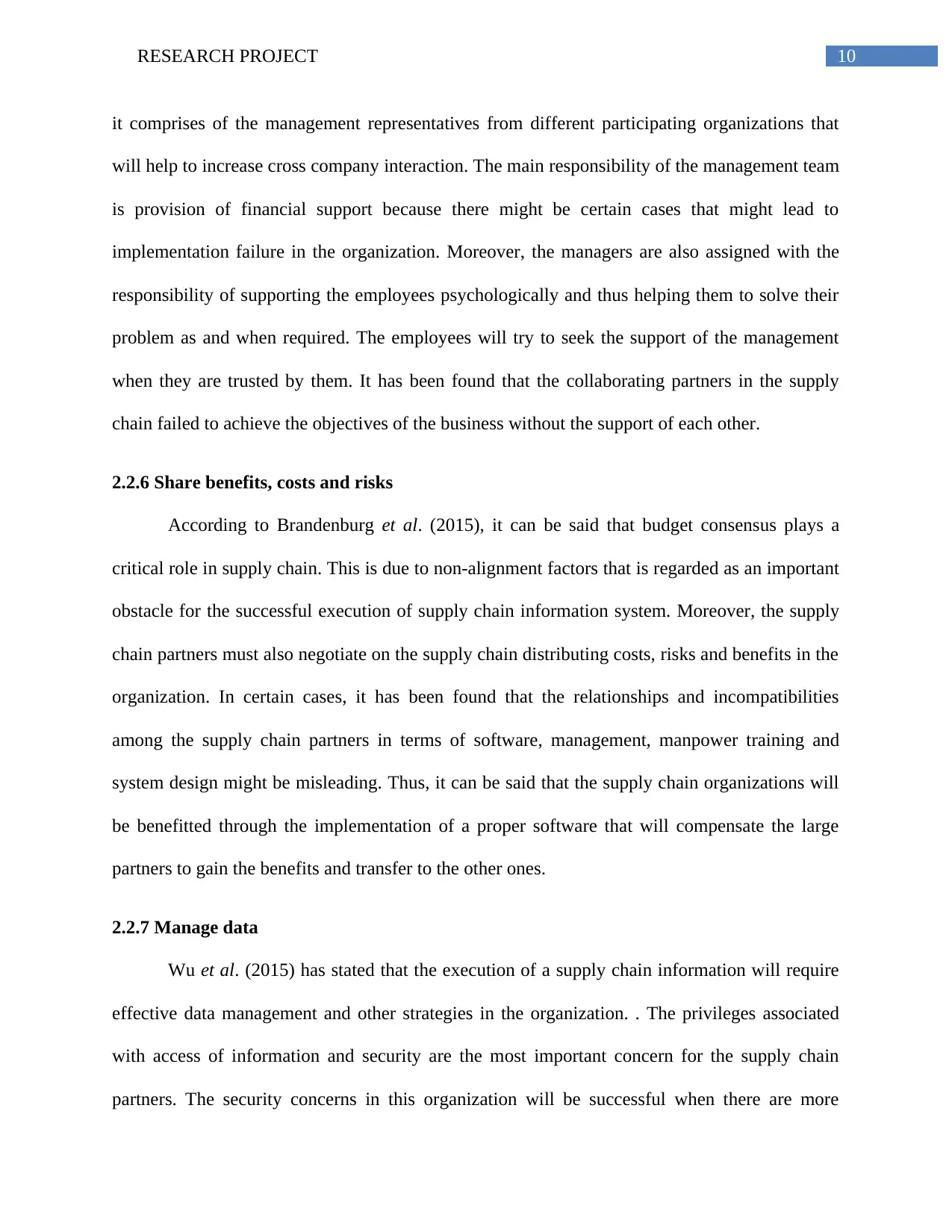
10RESEARCH PROJECT
it comprises of the management representatives from different participating organizations that
will help to increase cross company interaction. The main responsibility of the management team
is provision of financial support because there might be certain cases that might lead to
implementation failure in the organization. Moreover, the managers are also assigned with the
responsibility of supporting the employees psychologically and thus helping them to solve their
problem as and when required. The employees will try to seek the support of the management
when they are trusted by them. It has been found that the collaborating partners in the supply
chain failed to achieve the objectives of the business without the support of each other.
2.2.6 Share benefits, costs and risks
According to Brandenburg et al. (2015), it can be said that budget consensus plays a
critical role in supply chain. This is due to non-alignment factors that is regarded as an important
obstacle for the successful execution of supply chain information system. Moreover, the supply
chain partners must also negotiate on the supply chain distributing costs, risks and benefits in the
organization. In certain cases, it has been found that the relationships and incompatibilities
among the supply chain partners in terms of software, management, manpower training and
system design might be misleading. Thus, it can be said that the supply chain organizations will
be benefitted through the implementation of a proper software that will compensate the large
partners to gain the benefits and transfer to the other ones.
2.2.7 Manage data
Wu et al. (2015) has stated that the execution of a supply chain information will require
effective data management and other strategies in the organization. . The privileges associated
with access of information and security are the most important concern for the supply chain
partners. The security concerns in this organization will be successful when there are more
it comprises of the management representatives from different participating organizations that
will help to increase cross company interaction. The main responsibility of the management team
is provision of financial support because there might be certain cases that might lead to
implementation failure in the organization. Moreover, the managers are also assigned with the
responsibility of supporting the employees psychologically and thus helping them to solve their
problem as and when required. The employees will try to seek the support of the management
when they are trusted by them. It has been found that the collaborating partners in the supply
chain failed to achieve the objectives of the business without the support of each other.
2.2.6 Share benefits, costs and risks
According to Brandenburg et al. (2015), it can be said that budget consensus plays a
critical role in supply chain. This is due to non-alignment factors that is regarded as an important
obstacle for the successful execution of supply chain information system. Moreover, the supply
chain partners must also negotiate on the supply chain distributing costs, risks and benefits in the
organization. In certain cases, it has been found that the relationships and incompatibilities
among the supply chain partners in terms of software, management, manpower training and
system design might be misleading. Thus, it can be said that the supply chain organizations will
be benefitted through the implementation of a proper software that will compensate the large
partners to gain the benefits and transfer to the other ones.
2.2.7 Manage data
Wu et al. (2015) has stated that the execution of a supply chain information will require
effective data management and other strategies in the organization. . The privileges associated
with access of information and security are the most important concern for the supply chain
partners. The security concerns in this organization will be successful when there are more

11RESEARCH PROJECT
competitors who are involved in the supply chain process. The concerns related to data can be
coped up with the help of adequate training, firewalls and safeguards. These data might be
accurate and the supply chain partners do not share the information accurately due to varied
operational practices and information systems in the organization.
2.2. 8 Train the users and manage change in the organization
Wu et al. (2015) has predicted that in the implementation of supply chain information
system, there might be disinclination in using the information system and to share accurate
information with the users. The employees will prefer status quo and they are ready to change as
and when required in implementation of the supply chain framework in the organization. The
user from different participating organizations also gets concerned in the selection and design of
the information system and gain confidence in this process. It can be said that the increasing
confidence in the system might be achieved through proper training and realistic expectations.
Moreover, appropriate training will educate the users on the working of the system and the
benefits derived from it.
2.2.9 Monitor and evaluate performance
According to Govindan et al.(2014), the vision and objectives must be built properly
among the supply chain partners. Moreover, there must be performance measurement team who
will be paid attention for the non-aligned measurements and thus they form crucial barriers for
the supply chain management. These performance measurement must also support the supply
chain processes and the varied information security in the organization. Thus, it can be said that
performance measurements are constructed among the firms and the implementation process and
direction might vary in the organization.
competitors who are involved in the supply chain process. The concerns related to data can be
coped up with the help of adequate training, firewalls and safeguards. These data might be
accurate and the supply chain partners do not share the information accurately due to varied
operational practices and information systems in the organization.
2.2. 8 Train the users and manage change in the organization
Wu et al. (2015) has predicted that in the implementation of supply chain information
system, there might be disinclination in using the information system and to share accurate
information with the users. The employees will prefer status quo and they are ready to change as
and when required in implementation of the supply chain framework in the organization. The
user from different participating organizations also gets concerned in the selection and design of
the information system and gain confidence in this process. It can be said that the increasing
confidence in the system might be achieved through proper training and realistic expectations.
Moreover, appropriate training will educate the users on the working of the system and the
benefits derived from it.
2.2.9 Monitor and evaluate performance
According to Govindan et al.(2014), the vision and objectives must be built properly
among the supply chain partners. Moreover, there must be performance measurement team who
will be paid attention for the non-aligned measurements and thus they form crucial barriers for
the supply chain management. These performance measurement must also support the supply
chain processes and the varied information security in the organization. Thus, it can be said that
performance measurements are constructed among the firms and the implementation process and
direction might vary in the organization.
⊘ This is a preview!⊘
Do you want full access?
Subscribe today to unlock all pages.

Trusted by 1+ million students worldwide
1 out of 42
Related Documents
Your All-in-One AI-Powered Toolkit for Academic Success.
+13062052269
info@desklib.com
Available 24*7 on WhatsApp / Email
![[object Object]](/_next/static/media/star-bottom.7253800d.svg)
Unlock your academic potential
Copyright © 2020–2025 A2Z Services. All Rights Reserved. Developed and managed by ZUCOL.





